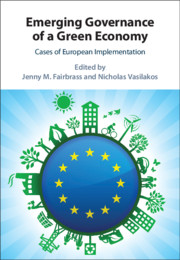Book contents
- Emerging Governance of a Green Economy
- Emerging Governance of a Green Economy
- Copyright page
- Contents
- Figures and Tables
- Contributors
- Preface
- Book Synopsis
- Acknowledgements
- Abbreviations
- 1 The Green Economy
- 2 The Green Economy
- 3 The Green Economy as Good Governance
- 4 On the Verge of a Second Revolution in the European Union’s Utilities Market for Energy Production?
- 5 ‘Great Expectations’
- 6 Overcoming Structural Disadvantages with Local Green Economies?
- 7 Shifting Models of Energy Companies towards Green Economy in Europe
- 8 Carbon Calculation and the Urban Green Economic Opportunity
- 9 The Green Economy
- Index
- References
2 - The Green Economy
Changing Meanings in a Changing World
Published online by Cambridge University Press: 20 January 2021
- Emerging Governance of a Green Economy
- Emerging Governance of a Green Economy
- Copyright page
- Contents
- Figures and Tables
- Contributors
- Preface
- Book Synopsis
- Acknowledgements
- Abbreviations
- 1 The Green Economy
- 2 The Green Economy
- 3 The Green Economy as Good Governance
- 4 On the Verge of a Second Revolution in the European Union’s Utilities Market for Energy Production?
- 5 ‘Great Expectations’
- 6 Overcoming Structural Disadvantages with Local Green Economies?
- 7 Shifting Models of Energy Companies towards Green Economy in Europe
- 8 Carbon Calculation and the Urban Green Economic Opportunity
- 9 The Green Economy
- Index
- References
Summary
The term ‘green economy’ re-emerged over a decade ago as a buzzword in notably inconclusive discussions across the globe amongst politicians, civil servants, business, non-governmental organisations (NGOs), community interest groups, the media and academics. By offering the possibility of integrating economic priorities with more ecologically sensitive and socially just forms of overall progress, the concept of a green economy outwardly seems to provide some guidance and direction for achieving long-term sustainability across a range of tiers of governance and different types of economy. We argue that the notion of a green economy remains elusive and is deeply disputed, often poorly understood and unevenly applied. Hence, it is in danger of remaining both unworkable and marginalised. This chapter traces the development of the concept, not only in Europe but beyond, in order to provide context for the deliberations in Europe. The chapter also outlines contemporary debates, and identifies emerging themes in order to argue that the idea of a green economy, as currently practiced, requires urgent rethinking and application. This chapter also furnishes background for the remainder of this edited volume, in which European case studies are presented that grapple with definitional issues and the practical challenges of implementation.
Keywords
- Type
- Chapter
- Information
- Emerging Governance of a Green EconomyCases of European Implementation, pp. 14 - 33Publisher: Cambridge University PressPrint publication year: 2021
References
- 4
- Cited by

